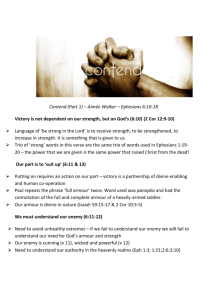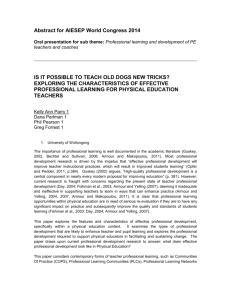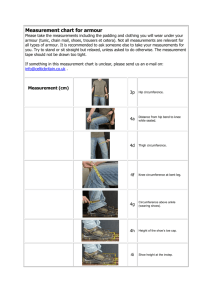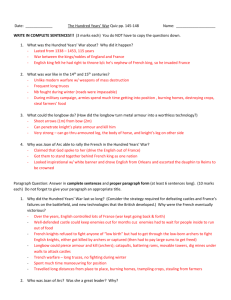Steppe nomadic armour from Birka
advertisement
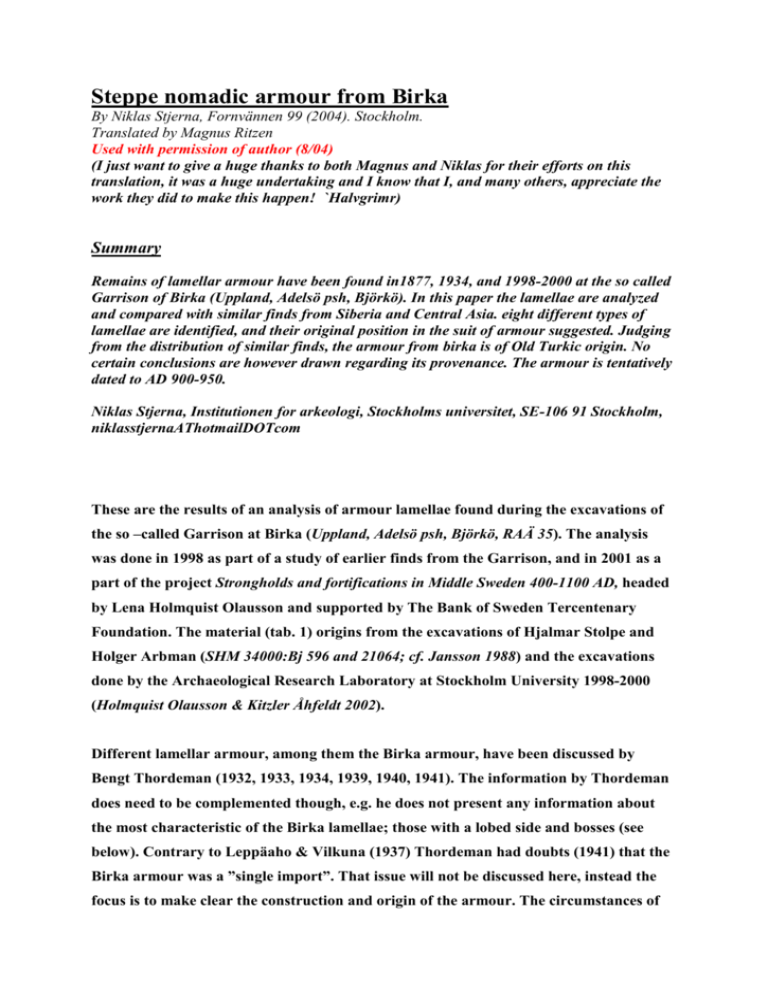
Steppe nomadic armour from Birka By Niklas Stjerna, Fornvännen 99 (2004). Stockholm. Translated by Magnus Ritzen Used with permission of author (8/04) (I just want to give a huge thanks to both Magnus and Niklas for their efforts on this translation, it was a huge undertaking and I know that I, and many others, appreciate the work they did to make this happen! `Halvgrimr) Summary Remains of lamellar armour have been found in1877, 1934, and 1998-2000 at the so called Garrison of Birka (Uppland, Adelsö psh, Björkö). In this paper the lamellae are analyzed and compared with similar finds from Siberia and Central Asia. eight different types of lamellae are identified, and their original position in the suit of armour suggested. Judging from the distribution of similar finds, the armour from birka is of Old Turkic origin. No certain conclusions are however drawn regarding its provenance. The armour is tentatively dated to AD 900-950. Niklas Stjerna, Institutionen for arkeologi, Stockholms universitet, SE-106 91 Stockholm, niklasstjernaAThotmailDOTcom These are the results of an analysis of armour lamellae found during the excavations of the so –called Garrison at Birka (Uppland, Adelsö psh, Björkö, RAÄ 35). The analysis was done in 1998 as part of a study of earlier finds from the Garrison, and in 2001 as a part of the project Strongholds and fortifications in Middle Sweden 400-1100 AD, headed by Lena Holmquist Olausson and supported by The Bank of Sweden Tercentenary Foundation. The material (tab. 1) origins from the excavations of Hjalmar Stolpe and Holger Arbman (SHM 34000:Bj 596 and 21064; cf. Jansson 1988) and the excavations done by the Archaeological Research Laboratory at Stockholm University 1998-2000 (Holmquist Olausson & Kitzler Åhfeldt 2002). Different lamellar armour, among them the Birka armour, have been discussed by Bengt Thordeman (1932, 1933, 1934, 1939, 1940, 1941). The information by Thordeman does need to be complemented though, e.g. he does not present any information about the most characteristic of the Birka lamellae; those with a lobed side and bosses (see below). Contrary to Leppäaho & Vilkuna (1937) Thordeman had doubts (1941) that the Birka armour was a ”single import”. That issue will not be discussed here, instead the focus is to make clear the construction and origin of the armour. The circumstances of the find will neither be discussed, as the armour then needs to be viewed in context with all other finds at the Garrison. The Birka Armour Among the most well preserved material are some of Stolpe’s finds from 1877 and one larger piece, consisting of twelve lamellae, from Arbman’s excavation. The material from recent year’s excavations is not as well preserved and has during this work not changed any results of the analysis. To be able to compare the lamellae easily, I made contour drawings on transparent film then stacked them on top of each other. The lamellae have a pattern… <end page 27> Table 1 - The Examined Material Examination Number of Number Lamellar types** lamellae/Fragments analysed* A1 A2 A3 B C D E F ? Stople Ar 1877 SHM Inv. 34000:596 275 119 37 2 19 8 15 - - 1 37 Arbman Ar 1934 SHM 21064 201 56 4 - 8 1 11 1 4 9 18 Holmquist Olausson Ar 1998-2000 244 92 - - 10 - 3 - - 17 62 Total 720 267 41 2 37 9 29 1 4 27 117 * Lamellae/fragments where original length or width was measurable ** Lamellar types identified from the lamellae/fragments that was measurable. Fragments identified by type in the other material are not included. of holes in them, through which they are linked together with thongs. During the comparison and grouping of the lamellae, special notice was taken of the position of these holes as well as the corner radius. The material was thus divided into eight types (A1-A3,B-F;fig 1a). Uncertain cases were not classified. A caliper was used to measure width and length on 267 lamellae/lamella fragments. Width and length was measurable on 18 pc, width alone on 247 pc. and length alone on 2 pc. Since the ambition was to not measure more than one fragment from each individual lamella, effort was made to puzzle together as many fragments as possible. The number of lamellae of various widths seemed to largely confirm the distribution into types (fig. 2). This is of no great concern though, as the width was instrumental in the manual distribution into types, which of course does not make the two methods independent of each other. The lamellae has been identified by the following types: A1 - Width approx. 27 mm, length approx. 100 mm with one vertical pair of holes at the upper edge, two vertical pairs of holes along each side edge, one horizontal pair of holes along the lower edge and one hole in the centre. Either the left or the right side is lobed. Three small bosses next to the lobed side. A2 - Width approx. 27 mm, length approx. 100 mm with one vertical pair of holes at the upper edge, two vertical pairs of holes along each side edge, one horizontal pair of holes along the lower edge and one hole in the centre. Either the left or the right side is lobed. A3 - Width approx. 27 mm, length approx. 100 mm with one vertical pair of holes at the upper edge, two vertical pairs of holes along each side edge, one horizontal pair of holes along the lower edge and one hole in the centre. B - Width approx. 29 mm, length approx. 100 mm with one vertical pair of holes at the upper edge, at least two vertical pairs of holes along each side edge, one horizontal pair of holes along the lower edge and one hole in the centre. Wider at lower edge than at upper edge. C1/C2 - Width approx. 21 mm, (var. 1) and 24 mm (var. 2), length approx. 80 mm with one vertical pair of holes at the upper edge, one vertical pair of holes along each side edge, one horizontal pair of holes along the lower edge and one hole in the centre. Wider at upper edge than at lower edge. D - Width 29 mm, length 58 mm with one vertical pair of holes at the upper edge, one vertical pair of holes along each side edge, one horizontal pair of holes along the lower edge and one hole in the centre. E - Width approx. 38 mm, length approx. 50 mm with one vertical pair of holes at the upper edge, one vertical pair of holes along each side edge, one vertical pair of holes (alternatively a single hole) at the lower edge. <end page 28> Fig. 1 a) Lamella types (A-F) from Birka, b) Decorated part of the Birka armour, reconstruction F - Width approx. 14 mm, length approx. 45 mm with one vertical pair of holes along each side edge, one horizontal pair of holes along one of the short edges. A vertical ridge in the centre. A few deviations regarding the number of holes and their placement is present in the material, probably because of how the lamellae are positioned in relation to each other. E.g. centre holes should be missing in the lowest part of the armour. The construction of the armour and archaeological parallels Compared to those lamellae depicted by Thordeman (1939) in Armour from the battle of Wisby 1361, the Birka lamellae matches the perforation of the lamellae from the Gyantse monastery (Tibet), Turpan and San Pao (East Turkestan/Xinjiang, China): one vertical pair of holes at the upper edge, two vertical pairs of holes along each side edge, one horizontal pair of holes along the lower edge and one hole in the centre. One preserved lamellar armour from Niari in Tibet is perforated using the same system except for the lower pair of holes on the Birka armour where there are but a single hole on the Tibetan armour. The lacing should regardless be the same on the Birka and on the Niari armour. This system, where rows of lamellae are suspended loosely from each other by their centre holes are distinctively different from solid laced lamellar armour as seen on the Byzantine emperor Basil II in the famous Psalter (cod. gr. 17, fol. 3), from shortly after 1017 in the Marciana library in Venice (Dawson 1998; cf. Olausson 2001). Anita Malmius has examined thirty lamellae… <end page 29> Fig. 2 Number of lamellae of various widths and the distribution of types …which appeared to have traces of lacing, but she did not find any textile or leather residue. Whatever material the lacing did consist of could thus not be established. The most discerning characteristic of the armour is the lobed lamellae (A1) with small bosses next to the lobed side. To easier compare the Birka armour to images of similarly decorated armour, a reconstruction drawing was made to recreate the visual appearance of laced lamellae (fig. 1 b). The reconstruction is based upon the mentioned above ”Tibetan” lacing system (Thordeman 1939 fig. 238). I have earlier (Stjerna 2001, s. 40 f) stated that the Birka armour is of a Central Asian type with close parallels in images from East Turkestan where, among others, reliefs displaying similarly curved outline can be seen (cf. Thordeman 1939; recently Gorelik 1995). The closest archaeological parallel to the Birka armour that I am aware of (fig. 3) has its origin from kurgan 11, Balyk-Sook, Altai (Kubarev 1998). This grave is dated AD 700-1000 and is linked to the Karai culture. The discovered lamellae have essentially the same perforation as the Birka lamellae. The lamellae of type 1 also have a rounded ridge in the middle, similar to those on some of the Birka lamellae and furthermore, have almost the same dimensions. Contrary, the lamellae of type 2, is in several cases bent inwards at the top, a trait not found on the Birka lamellae. One trait that the Birka lamellae share with those from Balyk-Sook is a thickness of up to 2-3 mm, a deviation from many other lamellae examples with a thickness regularly around 1 mm. These thinner lamellae are what are present from the mainly younger material from, among other places, Belarus (Plavinski 2001) and Russia. Gleb V. Kubarev (1998, s. 640; cf. Chudjakov 1986, s. 158) mentions a number of 19 findings that is comparable to the armour of Balyk-Sook, among them from the Russian provinces of Altai <end page 30> Fig. 3 A selection of lamellae from kurgan 11(?), Balyk-Sook, Altai, Russia (after Kubarev 1998 fig. 5), b) Armor from Balyk-Sook, reconstruction (after Kubarev 1998 fig. 6) …and Tuva. According to Kubarev, the armour bears resemblance to other Central Asian, especially Sogdian armours. He thus concludes that it can have been manufactured in a Sogdian workshop. This can also be the case of the Birka armour but until there is more support for such an assumption, the safest is to name its origin as Turkic. Similar lamellar armour was in use between AD 700-1000 and is generally connected to Turkic warriors of noble heritage. (Chudjakov 1986, s. 159). Conclusion Only in Central Asia and central Siberia one would find an equivalent with all of the traits of the Birka armour; the lobed side, the bosses, the position of the holes, the thickness of the lamellae and their varying shape. With the pictorial and archaeological parallels to the Birka armour in regard, the armour would have been designed to protect the chest, back, shoulders, thighs and knees. The lobed lamellae of type A1 can be assumed to only have covered the chest while the plain lamellae would have covered the back. There are examples from East Turkestan where lobed lamellae sometimes cover the lower body only, instead of the chest (Thordeman 1939 fig. 248). When it comes to the Birka armour, the few lamellae of type E could instead be remnants of a suspended protection for the thighs, or protection for the back below the waist; on one fragment reviewed by Arbman (1939, p. 63), lamellae of type E is obviously suspended from lamellae of type A3. The smaller lamellae of type C could have been part of shoulders while F-lamellae could have been some form of arm protection. It is in fact not certain if these last lamellae were part of the armour at all. I know of no Central Asian parallels to this lamellar type. The deposits from the phase of the Garrison to which the Birka armour belongs is dated to the mid 10th century AD, so tentatively it was produced during the first half of the 10th century AD. <end page 31> My gratitude to Anita Malmius and Margaretha Klockhoff for help and valuable discussions, and to project leader Lena Holmquist Olausson, all at the Archaeological Research Laboratory, Stockholm University. Thanks also to Sergei Kainov, Moscow who aided with information regarding parts of the eastern material. References Arbman, H. 1939. Birka. Sveriges äldsta handelsstad. Från forntid och medeltid 1. Stockholm. Chudjakov, J.S. 1986. Vooruzenie srednevekovych kocevnikov juznoj sibiri i central´noj azii. Novosibirsk. Dawson, T. 1998. Kremasmata, Kabadion, Klibanion. Some aspects of middle Byzantine military equipment reconsidered. Byzantine and Modern Greek Studies 22. Oxford. Gorelik, M.V. 1995. Vooruzenie narodov vostocnogo Turkestana. Litvinskij, B.A. (ed.). Vostocnyj Turkestan v drevnosti i rannem srednevkov´e. Moscow. Holmquist Olausson, L. & Kitzler Åhfeldt, L. 2002. Krigarnas hus. Arkeologisk undersökning av ett hallhus i Birkas Garnison. RAÄ 35, Björkö, Adelsö sn, Uppland 1998–2000. Arkeologiska Forskningslaboratoriet, Stockholms universitet. Unpublished. Jansson, I. 1988. Wikingerzeitlicher orientalischer Import in Skandinavien. Oldenburg – Wolin – Staraja Ladoga – Novgorod – Kiev. Handel und Handelsverbindungen im südlichen und östlichen Ostseeraum während des frühen Mittelalters. Mainz am Rhein. Kubarev, G.V. 1998. Der Panzer eines alttürkischen Ritters aus Balyk-Sook. Eurasia Antiqua 3. Mainz. Leppäaho, J. & Vilkuna, K. 1937. Muinais runojemme sobisopa. Kalevalaseuran vuosikirja 17. Porvoo. Olausson, M. 2001. Krigarens resa och hemkomst. Olausson, M. (red.). Birkas krigare. Stockholm. Plavinski, M.A. 2001. Zascerahal´nae uzbraenne IX-XIII st. na terytory Belarusi. Histarycna-archealagicny zbornik 16. Minsk. Stjerna, N. 2001. Birkas krigare och deras utrustning. Olausson, M. (ed.). Birkas krigare. Stockholm. Thordeman, B. 1932. En gotländsk medeltidsrustning av centralasiatisk typ. Arkeologiska studier tillägnade H.K.H. Kronprins Gustaf Adolf. Stockholm. — 1933. The asiatic splint armour in Europe. Acta Archaeologica 4. Copenhagen. — 1934. A persian splint armour. Acta archaeologica 5. Copenhagen. — 1939. Armour from the battle of Wisby 1361. 1. Text. Uppsala. — 1940. Rustningarna i Kalevala. Fornvännen 35. — 1941. Stridsdräkten under forntid och medeltid. Nordisk kultur. Samlingsverk. 15. B, Dragt. Stockholm.
